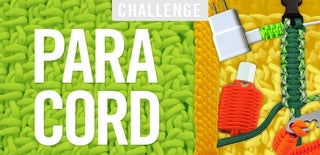Introduction: Paracord Deployment Bag
I was first introduced to Paracord back in the early 80's in the Civil Air Patrol. Been hooked ever since. Now, yes, the Paracord bracelet is a very cool idea in principal, but I have never been convinced it is the best way to carry paracord with you. I have worn my bracelet for over 11 years now, and I have no intention of disassembling it unless I was in a life or death circumstance. That being said, I use Paracord all the time and I carry it with me all the time. This is how I carry it...in a Paracord Deployment Bag. I originally made this 20 years ago to keep Paracord handy, and accessible at a moments notice. I designed this after the rescue deployment bags used in swift water rescue, only way smaller. My original one went missing after an outing a few weeks ago, and I feel lost with out it.Time for a new one, and I might as well document it...so here we go.........
Step 1: What You Need..
Items are simple:
5"X5" piece of cordura nylon
8" length of 1/8 bungee
Scissors
Polyester thread
Needle
Disclaimer, yes you can use a sewing machine, basting tape, neoprene, duck canvas, hemp, inner cords from paracord, crochet out of recycled grocery bags, leather, pleather, denim...a hundred different materials and a hundred different sewing methods...please don't ask "can I use, can I substitute" in the comments. Yes, you can do what ever you want and alter it as you see fit, this isn't an Arduino circuit, its a simple bag. This is how I made mine and it lasted 20 years...nuff said!
Step 2: Measuring and the Pattern
The cordura measured out about 5X5. What I really did was wrap my thumb with an inch or so of material on the sides. The technical term is eyeballing.
Fold it once so its inside out.
Step 3: Sew It...
Thread your needle with the thread, about 3 foot doubled over works.
Start sewing. Nothing fancy here, just a whip stitch. Pull it firm, but not cinched super tight.
Sew two sides stopping about 3/4 inch from the end.
Step 4: Make a Seam
Fold the end over creating a seam that your bungee will go thru.
Simple hem stitch all the way round.
Leave the ends open and run your needle through a few times at the corner to reinforce it.
Then secure it with a knot. Again, nothing fancy, a simple double hex surgeon knot will suffice...Yes, I am kidding ;o)
Step 5: Optional Step
I like to bury my tailing end of the thread after its been tied off. Just run it down the edge and cut it off. I don't know if this helps or not, but it makes me feel better.
Step 6: Run Your Bungee
This material is pretty stiff so its easy to push the bungee thru. You can use hemostats, wire or even a curved canvas needle if needed.
Step 7: Flip It Inside Out
I think the title says it all....look its a bag!
Step 8: Stuff It!
Your bag is ready, now stuff it.
Tie off your bungee and cinch it closed. You can leave a little tail out so you can rapidly deploy as much cord as needed, whenever you need it.
Step 9: Using It
As you can see, its about the size of my thumb, about 3 inches long. Easily fits in a pocket, on a belt loop or a key-chain. Perfect for EDC where rapid deployment of paracord may be needed. Easily refilled.
How much does it hold? With the rough dimensions I give here you can easily get 15 feet in there. BUT, as you break the bag in, it stretches a little, and as you get better at stuffing you can get an extra foot or two in there.
And there you have it. Simple and easy. Please share a pic if you make one.
Lex
This bag ended up holding 17 feet of paracord and is a bit over stuffed.
Please vote for me in the paracord contest

First Prize in the
Paracord Challenge













